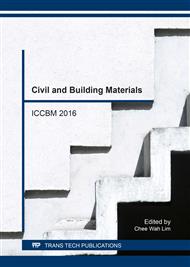[1]
Federación Interamericana del Cemento, Informe estadístico. Bogotá, (2013).
Google Scholar
[2]
P.K. Mehta, (1989). Pozzolanic and cementitious by products in concrete, Proceedings 3rd International Conference. 1 (1989), 1-43.
Google Scholar
[3]
J. Newman, B.S. Choo, Advanced concrete technology , first ed., Elsevier, England, (2003).
Google Scholar
[4]
CYTED, Red DURAR: Manual de inspección, evaluación y diagnóstico de corrosión en estructuras de hormigón armado, (1998).
DOI: 10.4995/thesis/10251/192263
Google Scholar
[5]
C. Andrade, R.D. Andrea, La resistividad eléctrica como parámetro de control del hormigón y de su durabilidad, ALCONPAT. 2 (2011) 93-101.
DOI: 10.21041/ra.v1i2.8
Google Scholar
[6]
ASTM C778-02, Standard specification for standard sand (2002).
Google Scholar
[7]
ASTM C618-03, Standard specification for coal fly ash and raw or calcined natural pozzolan for use in concrete (2003).
DOI: 10.1520/c0618-00
Google Scholar
[8]
NMX-C-166-ONNCCE-2006, Contenido de agua por secado (2006).
Google Scholar
[9]
NMX-C-165-ONNCCE-2004, Determinación de la masa específica y absorción de agua del agregado fino (2004).
Google Scholar
[10]
NMX-C-073-ONNCCE-2004, Masa volumétrica (2004).
Google Scholar
[11]
NMX-C-088-ONNCCE-1997, Determinación de impurezas orgánicas en el agregado fino (1997).
Google Scholar
[12]
NMX-C-084-ONNCCE-2006, Partículas más finas que la criba 0. 075mm (No. 200) por medio de lavado (2006).
Google Scholar
[13]
NMX-C-071-ONNCCE-2004, Determinación de terrones de arcilla y partículas deleznables (2004).
Google Scholar
[14]
ASTM C128-04, Standard test method for density (specific gravity), and absorption of fine aggregate (2004).
Google Scholar
[15]
NMX-C-077-ONNCCE-1997, Análisis para concreto (1997).
Google Scholar
[16]
NMX-C-083-ONNCCE-2002, Determinación de la resistencia a la compresión de cilindros de concreto (2002).
Google Scholar
[17]
NMX-C-148-2010, Gabinetes y cuartos húmedos y tanques de almacenamiento para el curado de especímenes de mortero y concreto de cementantes hidráulicos (2010).
Google Scholar
[18]
ASTM C1585-04, Standard test method for measurement of rate of absorption of water by hydraulic-cement concretes (2004).
Google Scholar
[19]
ASTM G57-06, Standard test method for field measurement of soil resistivity using the wenner four-electrode method (2012).
DOI: 10.1520/g0057-06r12
Google Scholar
[20]
ASTM C597-02, Standard test method for pulse velocity through concrete (2002).
Google Scholar
[21]
Neville, A. M. and Brooks, J.J. (2010). Concrete Technology, second ed., Pearsson Education Limited, England, (2010).
Google Scholar


